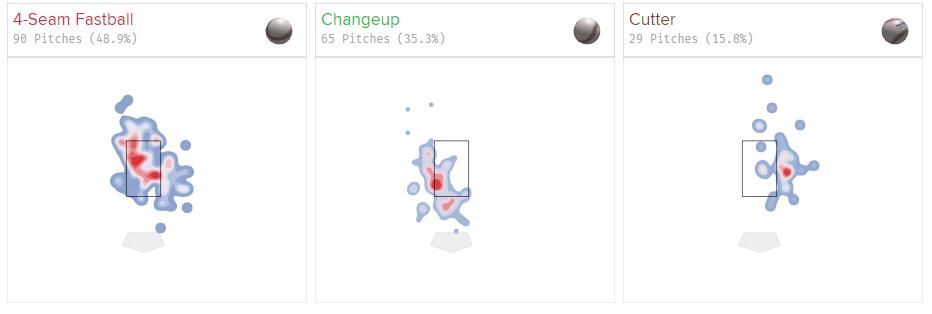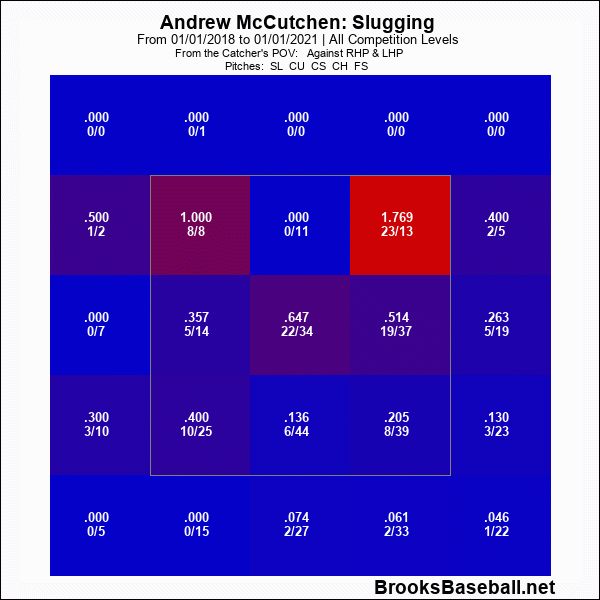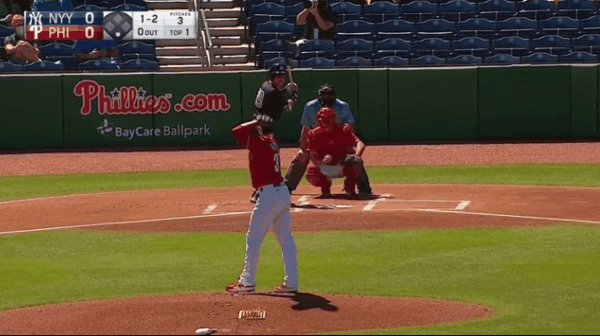If the Phillies are finally going to break their decade-long playoff drought — or, hell, even just top .500 — each member of the Opening Day roster has at least one thing they can improve on. Here’s something to track for every one.
Jose Alvarado: Quality Strikes
No one doubts the pure stuff. Alvarado hucked it up to 102 MPH this Spring, and his breaking ball is a scythe. But he tends to get erratic and wild, and more disciplined hitters tend to lay off his waste pitches no matter how nasty they look; opposing hitters rarely chase his elevated fastballs (20% since 2018, league average 28%) and non-fastballs overall (30% vs. 33% league average). Throwing more competitive pitches when ahead in the count could help build up his rep as a zone pounder, which could put hitters more on edge even when they know one of those big breakers is coming. It may not be possible given his delivery and velocity, but it could be what prevents him from becoming J.C. Romero.
Chase Anderson: Curveball
When it’s going right, Anderson’s curve gets grounders at a great clip (over 56% of his curveballs put in play over the last two seasons were ground balls), but it’s often a waste pitch that doesn’t entice enough hitters to go fishing for it. If he’s going to cut down on the home run rate that sunk his 2020, inducing more poor contact on low curveballs is a good place to start.
Alec Bohm: Fielding
Since there isn’t a lot you can say needed work on his performance at the plate last year, the easier focus is on Bohm’s defense. While Bohm should be athletic enough to hold down third base for a couple years, long stretches of poor performance or signs of early decay could be red flags for a team that already has a first baseman entrenched for two more years and nowhere else to put him before a DH is permanently installed. This warning is, for the moment, premature; Bohm had a couple of misplays in the field this Spring but hardly looked to be a disaster. The margin for error here just isn’t all that expansive.
Archie Bradley: Changeup
With the Reds last season, Bradley doubled his changeup use rate to great results: a .125 opp. AVG, 39% whiff rate, and 80 MPH average exit velo. If his fastball velocity loss trend continues, it’s going to be more important for Bradley to refine and deploy his secondaries, and a changeup emerging as a reliable third option to complement the fastball and curveball would be a welcome sight.
Connor Brogdon: Keep Nibbling
Brogdon’s overall numbers show a low rate of pitches in the zone, but that’s more a product of living on the black with his cutter and changeup than potential wildness.

If he keeps painting like that, he’ll continue to get good chase rates and, you’d figure, weaker contact.
Sam Coonrod: Get Ahead
Coonrod frequently fell behind in counts, with only a 62% first-pitch strike rate and nearly 1-in-5 PA going to a 2-0 count last season. The difference, as it tends to be, was stark: In the PAs where he started with a ball, opposing hitters torched Coonrod with a .345/.471/.527 line, while those that started 0-1 only ended up with a .141/.253/.282 line.
Zach Eflin: Top of the Order
If he’s truly going to fulfill his breakout promise this year, Eflin will need to better manage the top of opposing orders. In the past two seasons, the No. 1 and 2 hitters in opposing lineups combined to hit .294/.347/.509 and .411/.450/.857. His innings frequently got off on the wrong foot, as leadoff hitters (in all innings, not just the 1st) had a .387 OBP. Not painting himself into a corner and needing to work out of the stretch with no one out could be a stress reducer.
Didi Gregorius: Take Advantage
Last year, when ahead in the count, Gregorius produced a mere .314 SLG. He balanced things out a bit by clawing back in some ABs where he was behind, for sure, but in spots where he held the advantage he too frequently squandered them. Among hitters who had at least 50 PAs where they put the ball in play while ahead in the count (213 hitters in all), that .314 SLG was 12th-lowest. There’s room for extra damage in there.
David Hale: Eat Innings
Hale’s spot on the roster is to be a protector, to fall on the sword in lower-leverage spots where the game is out of reach in one direction or another, while the team awaits the return of JoJo Romero and the ramping-up of Spencer Howard. This season’s pitching situation will be hard to navigate, so even though it’s far from glamorous, Hale being able to successfully complete garbage time innings without catastrophe will help bide time.
Bryce Harper: Staying On the Field
There isn’t a ton I can say about Harper’s game that needs a lot of work. Don’t strike out as much? Sure, I guess. Take better routes in the field? I dunno, the routes seem okay too. The biggest concern right now just seems to be managing his workload and keeping him on the field, all while avoiding aggravation of the back issue that plagued him late last year and earlier this Spring. Back issues can ruin careers if they get bad enough, and we have not had nearly enough time to fully enjoy Bryce’s game here for that to be weighing on our minds.
Adam Haseley: Doubles
Haseley is not going to be a big home run guy. Maybe one year he’ll fall into 15 dingers somehow. More likely, he’s a guy who’ll go gap-to-gap and line-to-line for doubles to boost his power numbers, and that should probably be his focus. With a level, line-drive swing when at its best, Haseley’s focus shouldn’t turn to path adjustments. Though his overall EV dropped last year, Haseley hit more line drives and reduced his pulled balls in play, hopefully keeping defenses more honest and straight-up when guarding against him. He could be more Jon Jay than Jim Edmonds, and that’d be just fine.
Rhys Hoskins: Shorten the Slumps
Real easy for a guy like me to say from here, but the best way to prop Hoskins’s season numbers up with be to cut down the time he spends in the freezer. Since the start of 2018, only three players (including Bryce Harper and Carlos Santana) have had more hitless games started than Rhys’s 137. Some of that is balanced out with walks, but Rhys is certainly capable of more production and avoiding prolonged cold streaks could do wonders for everyone’s mental health, Rhys’s most of all.
Matt Joyce: Hang In Against Lefties
Barring injury, Joyce wouldn’t see everyday action. Even as a occasional platoon spell guy for Andrew McCutchen in left field, or in his duty off the bench, Joyce is likely to be deployed only against RHP who’ve not yet hit the 3-batter minimum. However! In those starts where he does end up facing a lefty, whether by (unlikely) start or by middle relief matchup, it would be good to keep Cutch resting and know that Joyce could put together a competitive AB. He’s slugged just .286 in limited exposure to lefties over the past two years, with relatively few strikeouts but lots of weak contact. With luck, these matchups will be a fringe case this year, but it always helps to be more well-rounded.
Brandon Kintzler: Come Through In the Clutch
It’s often said that “clutch” isn’t a skill, and it probably isn’t, but outcomes are still outcomes and guys who pitch in big spots need to come up big for this Phillies team to succeed. Last year, in 17 high-leverage appearances with Miami, Kintzler allowed an .832 opposing OPS with 10 strikeouts to 6 walks in 56 batters faced. Given the fluid roles of this Phils ‘pen, it’s fair to expect him to show up in big spots where the club may need a ground ball more than usual. With the delicate balance of Kintzler’s pitch-to-contact stuff and the Phils’ semi-suspect defense, these outcomes will be worth watching.
Andrew Knapp: Pinch-Hitting
Joe Girardi was a bit less inclined to use Knapp as a PH than Gabe Kapler was, but the Phillies could turn to Knapp off the bench more often this year as an option against LHP (if you figure Matt Joyce and Brad Miller get RHP priority, leaving Roman Quinn and Ronald Torreyes and Knapp’s main competition there). Knapp has always shown a decent eye and can certainly work a walk now and then, but his overall PH record (.214/.282/.271) leaves a whole lot to be desired. None of Knapp, Quin, or Torreyes is much of a power threat, but even just getting on base late in games, ahead of the top of the order, could do wonders for the Phils’ ability to steal a comeback win or add insurance runs.
Andrew McCutchen: Low Offspeed and Breaking Balls
In the past 3 seasons, McCutchen has an OPS of just .427 on offspeed pitches in the lower third of the zone and below. Among the 109 hitters who’ve handled at least 200 such pitches since 2018, that’s 4th-worst in the league. Low fastballs? Not a problem; his .382 average on those is top-5. It’s the bottom of the zone that he’s been unable to wrest control of. In a division with some slider-heavy powerhouses like Jacob deGrom and Max Scherzer (among others), McCutchen figures to see a good number of those kinds of pitches in ’21.
Brad Miller: Heaters
Miller has really begun to flourish as a part-time offensive threat, and the Phils will be strategic in how they use him this year. Regardless of when and how he’s used, though, he’s likely to see a fastball now and then, and those have (kind of ironically) been a bit of a bugaboo for him. Over the last two seasons, Miller’s whiff rate is higher against fastballs than any other kind of pitch, checking in at a rather towering 38% against 484 four-seamers seen. When he connects, he does plenty of damage (.519 SLG despite the whiffs), but connecting more could go a long way (like the balls likely will).
Matt Moore: Mo(o)re of This
Hector Neris: Luck
While he could also use a bit more regular command of his fastball to offset his splitter and new slider (and who knows how much he’s going to use that one), it would also be nice if the guy could catch a break.
Aaron Nola: Pickoff Moves
Thankfully, there’s not a ton that Nola needs to improve upon. He’s consistently been one of the game’s better starting pitchers for a few years now. But one thorn in his side, thought to be vanquished in 2019 but returned in 2020, is base stealing. J.T. Realmuto’s arrival curbed things a bit in 2019, when J.T. threw out 7 of 13 runners, but things regressed in last year’s smaller sample. Fluke? Portend? With Realmuto’s throwing hand and hip issues possibly lingering somewhat, it’ll be important for Nola to do his part in keeping some quicker runners honest with quicker pick-offs, as it’s probably not smart money to bet on him suddenly speeding up his delivery or incorporating a slide step more often.
Roman Quinn: Balls in Play
Quinn is an old school speedster, an anachronism in today’s game, but he hasn’t been able to fully gas up the jets and fly thanks to some gaudy K rates. They’ve steadily crept up over the past 3 seasons, from 24.5% to 27.9% to 33.6%, and there’s no way to unleash his speed on a walk back to the dugout. We saw a bit more live bunting practice this Spring, and that could be a sign of things to come. Either way, more contact (preferably line drives or on the ground, though Quinn is known to tank one every now and then) will give him more chances to pressure opposing defenses and wreak a bit of havoc on the bases.
J.T. Realmuto: Batting With RISP
It’s been feast-or-famine with runners in scoring position for J.T. in his time with the Phils so far. He’s hit 10 HR in 236 PA, but overall has posted averages of just .241 and .235, with OBPs of .276 and .288, over the last two seasons. He’s also K’d in 61 of those trips. So if he’s not parking one, odds are it hasn’t been going too well. This reflects back to Kintzler’s note above about whether clutch hitting is any kind of “skill,” and in continuing to avoid definitively answering that I’ll just instead point to J.T.’s RISP performance in the 3 seasons before the trade: .287/.341/.365, .277/.363/.416, .296/.371/.459. He’s clearly capable, he’s just gotta be himself in those spots.
Jean Segura: Quality Contact
It’s easy (and worth doing) to heavily discount a good amount of 2020 performance numbers. It was just a weird year. And that weirdness is a little extra profound in some of the approach numbers that Segura posted, wildly bucking some trends he had pretty steadily established in years prior. His swinging strike rate jumped to a career high, and his K rate followed to a similar height. But he also walked more than ever, and his overall ball-in-play percentage fell through the floor to 65%. One of Segura’s hallmarks has been that he’s a contact hitter who puts the ball in play 75-80% of the time he shows up at the plate, and if he’s going to bat in the lower half of the Phils’ order behind on-base machines like Hoskins and Harper instead of in front of them, balls in play will be extra important.
Ronald Torreyes: Whole Lotta Glove
Expectations aren’t necessarily sky-high for Torreyes’s impact as a bat off the bench, or even as a pinch runner. His impact will be felt most on the infield, where his defense will either keep him afloat on the roster into the summer, or be the reason he gets the boot the moment Scott Kingery is ready to jump back in. And that second one might happen anyway. But for the time he is on the roster, Torreyes will need to be ready to go at any infield position for spot starts, and if he can’t be counted on to fill gaps, that would be a problem. To his credit, Statcast grades his infield defense out as pretty close to baseline, albeit in limited attempts the last two years. There stands to be extra importance in these defensive innings for a team that could use every marginal break it can get.
Vince Velasquez: Better First Pitches
Regardless of whether he’s starting or relieving, one of Velasquez’s most painful Achilles heels has been the first pitch of an AB. Since 2018, only Trevor Richards (.828) has allowed a higher opposing SLG on first pitches than Vinny’s .767, and Velasquez has never had a season where hitters didn’t cumulatively SLG at least .600 on his first pitch. Not that it’s much better to waste more first pitches, either; hitters have an .862 career OPS against Velasquez after getting ahead 1-0, including OPSes of .931 and 1.035 in the last two years. It is, technically(?), an improvement over those first-pitch numbers, though. It’s hard to say what a remedy would look like, given Velasquez’s stuff hasn’t really evolved over the years. It could be a matter of good breaks, but that just sets us all up for a bunch of teeth grinding with every new hitter that steps in against him.
Zack Wheeler: Rediscover Strikeouts
Wheeler found an odd amount of success last season despite a precipitous strikeout drop, as his K% fell below 19 after consecutive years above 23. That’s not exactly a recipe for success in today’s game. And we can all see Wheeler’s got the raw stuff, still, to overpower hitters, and he posted 22 strikeouts in his 19.1 Spring innings. A blend of the power he had in his later Mets days with the finesse of his first Phillies season could produce something tasty, it may just be a matter of measuring the ingredients properly.


